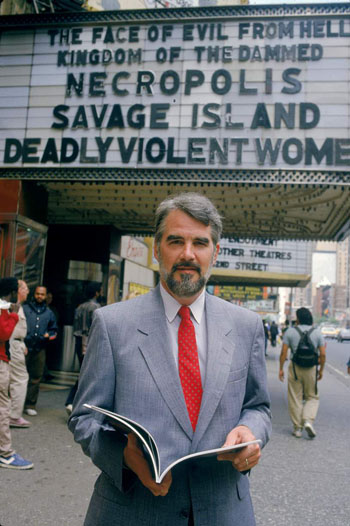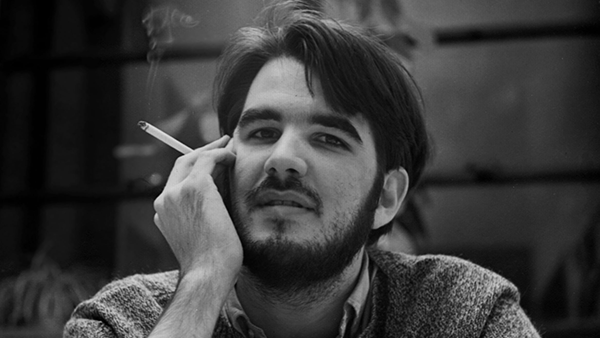“On Thursday night, following a major stroke that felled him a week ago, Richard Corliss, 71, died in New York City,” writes Richard Zoglin for Time, where Corliss “was an indestructible, inexhaustible resource. He wrote some 2,500 reviews and other articles for the magazine, including more than two dozen cover stories. He covered, at various times, theater and television, wrote about theme parks and Las Vegas shows, contributed cover stories on topics as far afield as yoga and Rush Limbaugh. And as Time‘s longest-serving movie critic (and perhaps the magazine’s most quoted writer of all time), he was a perceptive, invaluable guide through three and a half decades of Hollywood films, stars and trends.”
Zoglin looks back on a career that began with freelance reviews for the National Review, SoHo Weekly News and New Times and eventually, in 1970, landed Corliss a job as editor of Film Comment. He stayed on for 20 years, taking on Jonathan Rosenbaum as a Paris correspondent, and then, as he was handing the reins to Richard T. Jameson, cast a worried eye on his profession: “All Thumbs: Or, Is There a Future for Film Criticism?” naturally drew a response from Roger Ebert: “All Stars: Or, Is There a Cure for Criticism of Film Criticism? Pt. 2.” In that same May/June 1990 issue, Corliss wrote: “I am grateful to Roger Ebert for responding to my article in the spirit in which I wrote it, as the opening of a civilized debate. We agree more than we differ, but that won’t keep me from picking a few spats.”
Time has collected 25 of Corliss’s most memorable reviews and, with “Remembering the Rememberer,” posted excerpts from Corliss’s many obituaries: “In these pieces he wedded an encyclopedic knowledge of culture with a singular understanding of the relationship between artist and audience.”
Updates, 4/25: “I wouldn’t be who I am today without the recognition, insight and mentoring of Richard Corliss,” writes Anne Thompson. “Richard plucked me from publicity, took me in at Film Comment as Associate Editor, tried to teach me how to write. He’d edit my copy, adding color and wit and sparkle that I lacked. I loved our collaboration…. His passions were endless. He could expound on obscure Korean masters, the genius of the Pixar system, go toe to toe with Michael Eisner, Steven Spielberg or Jeffrey Katzenberg, and tended to lean toward style over content. He understood how movies were made, and he and his wife Mary, who was a long-time curator of the film stills archive at The Museum of Modern Art, loved hanging out with the artists behind the movies, from art directors to cinematographers.”
Glenn Kenny on this photograph: “I didn’t meet Richard until, oh, well over twenty years after this picture was taken, and his mode for dealing with younger film critics was quite a bit more avuncular than anything this shot suggests. I still love this shot of him because he has this air of both confidence and poetic dreaminess, and also of potential extreme volubility. These qualities are always is present in his writing, and were always present in his conversation.”
“Whether intentionally or not,” writes Variety‘s Justin Chang, “he set himself up over the years as a sort of conscience to the critical community—a towering, goateed Jiminy Cricket who, every so often, would take time out from reviewing the movies to issue a gently barbed opinion on those aspects of the profession that troubled him most. Whether you agreed with him or not, his gripes, such as they were, conveyed far more humility than superiority, arising as they did from a searching, self-effacing and always generous intelligence.”
Bruce Weber in the New York Times: “Mr. Corliss’s work shone brightest when he could vent his eclectic enthusiasms, from George Lucas and Quentin Tarantino to Ingmar Bergman and François Truffaut, from Chinese kung fu films to Disney animation, from high-minded, ambience-saturated dramas like Anthony Minghella’s The English Patient to quirky teen tales like John Hughes’s The Breakfast Club…. Mr. Corliss promoted screenwriters against the headwind of opinion that said movies were made by auteur directors. He expressed adoration of movie stars as different as James Stewart and Cameron Diaz. In a 1985 review of the comedy-thriller Into the Night, he described Michelle Pfeiffer as ‘drop-dead gorgeous,’ purportedly coining the phrase.”
Back in Time, Richard Lacayo: “Richard Corliss was a jovial, bearish man who was almost always to be found in signature footwear—custom-made sneakers imprinted with the logos of the major Hollywood studios. Can there be such a thing as a rumpled dandy? That would be one way to describe him, his nice mix of informality and urbanity.”
Time‘s also collected statements from Steven Spielberg, Martin Scorsese, Kathryn Bigelow and more filmmakers. Plus another selection, “some of our favorite offbeat, passionate pieces from the Corliss archive.”
At Criticwire, Sam Adams has collected tweeted reactions to the news. And at Film Comment, you can revisit David Thomson‘s 2013 interview with Corliss.
Updates, 4/26: “You got the sense that he could get along with anyone while still being his own man and not cutting the legs out from under anybody else, and that he could disagree without being disagreeable,” writes Matt Zoller Seitz at RogerEbert.com. “These are rare qualities, and they came through in his work. All of it…. There was a marvelous period in the 90s and early aughts when he seemed to be everywhere at once. He was not just writing regular film criticism, he was also traveling throughout the United States reporting on various artistic, athletic, cultural and architectural subjects, including boxing, theme parks, and the transformation of Las Vegas…. I can’t even begin to tell you how inspiring this sort of Corliss piece was to me, as a then-young critic who’d started out writing mostly film and video criticism, but had grown up reading Tom Wolfe and Hunter Thompson and Joan Didion as well, and wanted to be taken halfway seriously as a reporter as well as somebody spouting opinions.”
“Dressed and coiffed just a bit differently, it was easy to picture him, cigarette in hand or mouth, as an unflappable, quip-ready supporting character in anything from Twentieth Century to All About Eve,” writes the Hollywood Reporter‘s Todd McCarthy. “As it was, Richard bridged that sophisticated world and the one of the ’60s/’70s breed of film buff spawned by Andrew Sarris and Pauline Kael, foreign films and the movie brat generation of American directors…. I will always be in his debt for giving me my first national visibility as a writer about films as West Coast correspondent for the magazine in the second half of the ’70s.”
Updates, 4/27: “Read him at age 21, read him at 71, read him anywhere in between, and you’re in the company of a sensibility insatiably curious, nimble as a springbok, focused as a base runner, fresh as a croissant on a sunny Cannes morning,” writes Richard T. Jameson at RogerEbert.com. Corliss “conceived of Film Comment as a writer’s magazine…. Besides Sarris and by all means Corliss himself, the magazine regularly featured first-rate, challenging, authoritative figures such as Robin Wood (whose book Hitchcock’s Films had revolutionized British and American thinking about that director’s work), Joseph McBride, Molly Haskell, David Thomson (who came along a bit later, and ruled), Raymond Durgnat, Richard Roud, Brendan Gill, and Paul Schrader (whose 1972 ‘Notes on Film Noir‘ remains the definitive introduction to and disquisition on that cinematic darkbloom). One of the thrilling things about Film Comment—especially for other, aspiring writers—was that names like these were given prominence on the cover right along with Hitchcock, Hawks, Truffaut, et al.” Jameson, who succeeded Corliss as editor, then recalls what it was like to work with Corliss as a contributing writer.
From the Film Society of Lincoln Center, which, of course, publishes Film Comment: “Shortly before he passed away, he wrote this piece for our 42nd Chaplin Award Gala honoring Robert Redford on April 27. We hope that, as you read it, you join us in reflecting on Corliss’s tireless contributions to criticism and film culture. R.I.P., Richard. You will be missed.”
Updates, 4/30: From David Bordwell: “Richard gave us a new model of film magazines: richly designed, provocative ([Raymond] Durgnat especially), and sending the signal that everything cinematic could be studied.” What’s more, “Richard might be the most imitated critic of recent decades…. The Richard I followed most closely was on display in long formats.” Besides Talking Pictures: Screenwriters in the American Cinema (1974), the “other Richard book I hold close is his BFI monograph on Lolita, a sustained critical tightrope act…. [E]very paragraph scatters pieces of candy.”
“Richard could hold forth (though he never pontificated) on almost any topic—and did so frequently in my encounters with him in Venice in the ensuing years,” writes Peter Cowie. “During one of my panels, he talked about the spaghetti Western and its influence on Tarantino, and discussed the quirkish characteristics of Sergio Corbucci at length and without a hint of condescension. In 2009, we celebrated, a few months in advance, the centenary of Kurosawa’s birth, and in 2012 we extolled the virtues of microbudget filmmaking, with Richard discussing Maya Deren and Stan Brakhage alongside such less experimental, if equally low-budget, movies as The Immoral Mr. Teas, El mariachi, and The Blair Witch Project, which had struck it rich at the box office…. Richard prized Venice above all festivals, I think, because the city itself and the atmosphere it exudes seemed to accord with his vision of cinema—rooted in an enchanted past and yet open to new directions.”
Update, 5/10: “Dark, handsome, and bear-like (eye candy, in fact!), he liked and loved women (though his heart was devoted to one),” recalls Molly Haskell, writing for Film Comment, “and wrote acutely sensitive think pieces on actresses (did he ever call them actors?) in the context of changing roles. He left such a blizzard of good prose and provocative commentary, it will take a while to sift through it, and comprehend just how very good he was. His death is a great shock and sadness—I will miss him terribly, his voice, his enthusiasms, his connection to the past.”
For news and tips throughout the day every day, follow @KeyframeDaily. Get Keyframe Daily in your inbox by signing in at fandor.com/daily.





